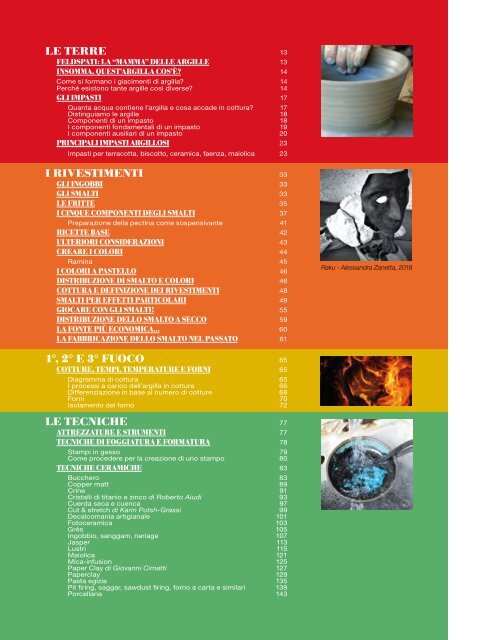Ceramica Artistica: materiali tecniche storia di Edoardo Pilia
Ceramica Artistica: materiali tecniche storia di Edoardo Pilia acquistabile su Amazon: https://www.amazon.it/dp/1718076908/ref=sr_1_2 Grafica e impaginazione di Maria Giusi Ricotti - Il Calderone Magico
Ceramica Artistica: materiali tecniche storia di Edoardo Pilia
acquistabile su Amazon:
https://www.amazon.it/dp/1718076908/ref=sr_1_2
Grafica e impaginazione di Maria Giusi Ricotti - Il Calderone Magico
You also want an ePaper? Increase the reach of your titles
YUMPU automatically turns print PDFs into web optimized ePapers that Google loves.
LE TERRE 13<br />
FELDSPATI: la “Mamma” delle Argille 13<br />
Insomma, quest’ARGILLA cos’è? 14<br />
Come si formano i giacimenti <strong>di</strong> argilla? 14<br />
Perché esistono tante argille così <strong>di</strong>verse? 14<br />
Gli Impasti 17<br />
Quanta acqua contiene l’argilla e cosa accade in cottura? 17<br />
Distinguiamo le argille 18<br />
Componenti <strong>di</strong> un impasto 18<br />
I componenti fondamentali <strong>di</strong> un impasto 19<br />
I componenti ausiliari <strong>di</strong> un impasto 20<br />
Principali impasti argillosi 23<br />
Impasti per terracotta, biscotto, ceramica, faenza, maiolica 23<br />
i rivestimenti 33<br />
Gli INGOBBI 33<br />
GLI SMALTI 33<br />
LE FRITTE 35<br />
I cinque componenti DEGLI smaltI 37<br />
Preparazione della pectina come sospensivante 41<br />
Ricette base 42<br />
Ulteriori considerazioni 43<br />
Creare i Colori 44<br />
Ramina 45<br />
I Colori a Pastello 46<br />
Distribuzione <strong>di</strong> smalto e colori 46<br />
Cottura e definizione dei rivestimenti 48<br />
Smalti per effetti particolari 49<br />
Giocare con gli smalti! 55<br />
Distribuzione dello smalto a secco 59<br />
La fonte più economica… 60<br />
La fabbricazione dello smalto nel passato 61<br />
1°, 2° e 3° FUOCO 65<br />
Cotture, tempi, temperature e forni 65<br />
Diagramma <strong>di</strong> cottura 65<br />
I processi a carico dell’argilla in cottura 66<br />
Differenziazione in base al numero <strong>di</strong> cotture 68<br />
Forni 70<br />
Isolamento del forno 72<br />
Le TECNICHE 77<br />
ATTREZZATURE E STRUMENTI 77<br />
Tecniche <strong>di</strong> foggiatura e formatura 78<br />
Stampi in gesso 79<br />
Come procedere per la creazione <strong>di</strong> uno stampo 80<br />
Tecniche CERAMICHE 83<br />
Bucchero 83<br />
Copper matt 89<br />
Crine 91<br />
Cristalli <strong>di</strong> titanio e zinco <strong>di</strong> Roberto Aiu<strong>di</strong> 93<br />
Cuerda seca e cuenca 97<br />
Cut & stretch <strong>di</strong> Karin Putsh-Grassi 99<br />
Decalcomania artigianale 101<br />
Fotoceramica 103<br />
Grès 105<br />
Ingobbio, sanggam, neriage 107<br />
Jasper 113<br />
Lustri 115<br />
Maiolica 121<br />
Mica-infusion 125<br />
Paper Clay <strong>di</strong> Giovanni Cimatti 127<br />
Paperclay 129<br />
Pasta egizia 135<br />
Pit firing, saggar, sawdust firing, forno a carta e similari 139<br />
Porcellana 143<br />
Raku - Alessandra Zanetta, 2018<br />
Raku 149<br />
Protezione della fibra ceramica nel forno raku 162<br />
Cottura raku in forno elettrico 162<br />
Cottura raku in forno microonde 163<br />
Raku dolce <strong>di</strong> Giovanni Cimatti 165<br />
Raku dolce 167<br />
Raku nudo 171<br />
Raku ab-vara, obvara 177<br />
Rilievi in superficie 179<br />
Sali metallici, fumigazioni con sali/salatura 181<br />
Sintesi 185<br />
Spugna ceramica 189<br />
Terra sigillata <strong>di</strong> Giovanni Cimatti 191<br />
Terra sigillata 195<br />
Terzo fuoco 199<br />
Tecniche grafiche a terzo fuoco <strong>di</strong> Mirco Denicolò 201<br />
Trasferimento immagini 207<br />
Vaso Greco 211<br />
Villanoviano 215<br />
TECNICHE DI DecorazionE 217<br />
Agata 217<br />
Colori sopra-sotto smalto 217<br />
Graffito, incisione 217<br />
Intarsio-traforo 217<br />
Marmorizzazione 218<br />
Mascherine 218<br />
Mocha Tea 218<br />
Mosaico 218<br />
Pelle d’elefante 219<br />
Penna d’oca 219<br />
Pettine, conchiglie etc. 219<br />
Pompetta 220<br />
Riserva con gomma o grasso 220<br />
Rullini 220<br />
Spolvero 220<br />
Stampa 221<br />
Timbratura 221<br />
Tobi-Kanna 221<br />
Problemi e Soluzioni 223<br />
Problemi Generici 223<br />
Problemi dell’Impasto 225<br />
Problemi del Rivestimento 226<br />
STORIA della CERAMICA 233<br />
IL SIGNIFICATO 233<br />
L’ORIGINE 234<br />
L’esercito cinese <strong>di</strong> terracotta 235<br />
Le ceramiche orientali: i primi smalti e lustri 236<br />
La Mesopotamia e la Persia 237<br />
La ceramica dell’area greca 238<br />
Il villanoviano e il bucchero etrusco 240<br />
La ceramica romana 241<br />
La ceramica bizantina 242<br />
La ceramica islamica 242<br />
La ceramica ispano-moresca 243<br />
La ceramica italiana 244<br />
Il Me<strong>di</strong>oevo 244<br />
Il Rinascimento 245<br />
I Della Robbia 250<br />
Dall’antico al moderno: raku 252<br />
La Porcellana 254<br />
Il periodo 1700-1800 260<br />
Dal 1900 261<br />
Considerazioni finali 267<br />
Bibliografia 269<br />
SOMMARIO


